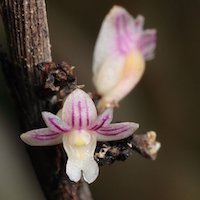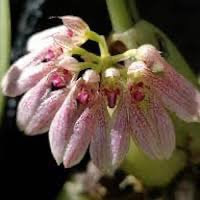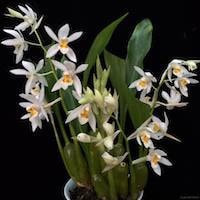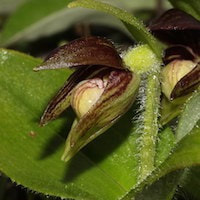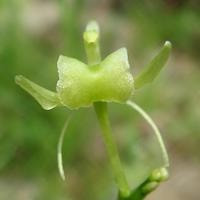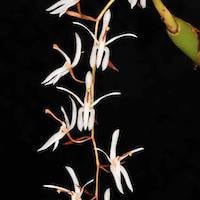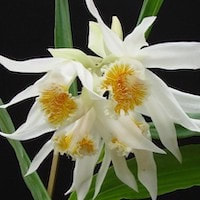Experience Pure Luxury with Women Fragrance Oil Oriental 6
The scented notes of this orchid fragrance oil vary in complexity and therapeutic benefits. One of these orchids is Dendrobium Aloifolium, a native Singaporean species that was considered critically endangered but was rediscovered in 2010. It is used in Oriental 6 (Women) for Team building Perfume workshop and is known for its vanilla-like fragrance, which adds beauty and complexity to perfumes. Fortunately, it is found in various parts of Southeast Asia, and efforts are being made to reintroduce it to Singapore.
Another orchid, Bulbophyllum andersonii, also known as Cirrhopetalum andersonii, is valued in traditional Chinese medicine for its therapeutic properties. Native to regions in China, Vietnam, Myanmar, and India, it is used to expel wind, remove dampness, improve blood flow, and treat rheumatism. The herb contains several unique compounds beneficial for health.
Coelogyne leucantha, or the "white flower pearl shell orchid," sourced from Yunnan, is utilized in herbal medicine to alleviate heat, stop coughs, improve blood flow, reduce pain, and promote bone and tendon repair.
Cypripedium elegans, a small orchid with fine white hairs, is known for its medicinal usage in India to treat nervous system disorders, hysteria, spasms, fits, insanity, epilepsy, and rheumatism in the Himalayan region.
Liparis kumokiri, also known as "spread snow grass," is a terrestrial herb found in the Russian Far East, Korea, and Japan. It is employed in traditional medicine to strengthen the constitution, improve blood and air flow, and address intermenstrual bleeding and discharge.
Otochilus porrectus, commonly called "Erchun Lan," is native to Nepal and used in traditional medicine to treat sinusitis, rheumatism, and as a tonic.
Thunia alba, also known as the "bamboo orchid," is widely distributed across various countries and is used in Chinese herbal medicine to enrich yin, benefit the lungs, clear phlegm, stop coughs, improve blood flow, remove bruises, and help heal fractures. It also finds use in Nepal to aid in fracture setting.
In addition to these orchids, there are other scent notes, including spices, lavender, rich musk, saffron, cashmeran, kephalis, tuber, amaranth, cognac, and Japanese pepper. These orchids and scent notes contribute to the diverse aromatic profile of perfumes and herbal remedies.
Another orchid, Bulbophyllum andersonii, also known as Cirrhopetalum andersonii, is valued in traditional Chinese medicine for its therapeutic properties. Native to regions in China, Vietnam, Myanmar, and India, it is used to expel wind, remove dampness, improve blood flow, and treat rheumatism. The herb contains several unique compounds beneficial for health.
Coelogyne leucantha, or the "white flower pearl shell orchid," sourced from Yunnan, is utilized in herbal medicine to alleviate heat, stop coughs, improve blood flow, reduce pain, and promote bone and tendon repair.
Cypripedium elegans, a small orchid with fine white hairs, is known for its medicinal usage in India to treat nervous system disorders, hysteria, spasms, fits, insanity, epilepsy, and rheumatism in the Himalayan region.
Liparis kumokiri, also known as "spread snow grass," is a terrestrial herb found in the Russian Far East, Korea, and Japan. It is employed in traditional medicine to strengthen the constitution, improve blood and air flow, and address intermenstrual bleeding and discharge.
Otochilus porrectus, commonly called "Erchun Lan," is native to Nepal and used in traditional medicine to treat sinusitis, rheumatism, and as a tonic.
Thunia alba, also known as the "bamboo orchid," is widely distributed across various countries and is used in Chinese herbal medicine to enrich yin, benefit the lungs, clear phlegm, stop coughs, improve blood flow, remove bruises, and help heal fractures. It also finds use in Nepal to aid in fracture setting.
In addition to these orchids, there are other scent notes, including spices, lavender, rich musk, saffron, cashmeran, kephalis, tuber, amaranth, cognac, and Japanese pepper. These orchids and scent notes contribute to the diverse aromatic profile of perfumes and herbal remedies.
Other fragrance oils- Oriental 1, Oriental 2, Oriental 3, Oriental 4, Oriental 5, Oriental 6, Oriental 7, Oriental 8, Oriental 9, Oriental 10, Oriental 11, Oriental 12
Download the guided mediation that works best with this Orchid fragrance oil
| women_oriental_essential_oil_orchi_00006.mp3 | |
| File Size: | 123613 kb |
| File Type: | mp3 |
Unleash Inner Serenity with Pure Orchid Bliss
Contains Scented Notes of following in various proportions:
Native Singaporean Orchid notes: Dendrobium Aloifolium
|
Dendrobium Aloifolium - Used in Oriental 6 (Women) for Team building Perfume workshop
Dendrobium Aloifolium is a species of orchid native to Singapore and is classified as Critically Endangered, facing the risk of extinction. However, in a fortunate turn of events, on September 9, 2010, during a survey conducted near the Upper Peirce and Upper Seletar Reservoirs, two clusters of Dendrobium aloifolium were discovered thriving on the swampy forest floor, concealed by thick leaf litter and under the shelter of a dense canopy cover. This remarkable rediscovery provided hope for the species' survival. The plant is renowned for its delightful fragrance, often likened to the scent of vanilla, as stated on Npark's website. However, some individuals describe the aroma as more intricate and captivating. Whether experienced on its own or blended with other scents in a perfume mix, Dendrobium Aloifolium's fragrance is truly enchanting. Despite its critical status in Singapore, Dendrobium Aloifolium is fortunately found across much of Southeast Asia. It thrives in lowland forest environments, ranging from sea level to an elevation of 500 meters. The discovery of this species in various regions gives hope for its potential resurgence in Singapore. Dendrobium Aloifolium's alluring scent and endangered status make it a significant and cherished ingredient in the creation of perfumes, particularly in the Oriental 6 (Women) fragrance used for team-building perfume workshops. Its rediscovery and distribution in other parts of Southeast Asia represent an opportunity for conservation efforts and a possible comeback in its native Singapore. |
Therapeutic Orchid notes:
|
Bulbophyllum andersonii also Cirrhopetalum andersonii and Cirrhopetalum henryi Rolfe
Chinese names: Shumaojuanban Lan (comb hat roll petal orchid), Chenhongjuanban Lan (orange color roll petal orchid) Chinese medicinal name: Yipicao Bulbophyllum andersonii, also known as Cirrhopetalum andersonii and Cirrhopetalum henryi Rolfe, is a beautiful orchid species native to several regions in China, including Guangxi, SW Sichuan, Guizhou, and Yunnan. It is also found in Vietnam, Myanmar, Sikkim, and India. The flowering period for this orchid varies, occurring from February to October in China and from September to October in Sikkim. In traditional Chinese medicine, Bulbophyllum andersonii is known as "Yipicao." Various parts of the entire plant are used for medicinal purposes. It is believed to have properties that help expel wind and remove dampness from the body. Additionally, it is utilized to improve blood flow and alleviate conditions such as coughs and retention of food. For rheumatism, a decoction of 6–15 grams of the plant is commonly prescribed. For feminine weakness, a soup made with 6–15 grams of the herb, along with chicken meat or pork, is recommended. The chemical composition of B. andersonii includes several compounds that contribute to its medicinal properties. One of the unique components is "cirrhopetalin," a phenanthrene derivative. Other important compounds found in this orchid are two bibenzyl derivatives called "cirrhopetalidin" and "cirrhopetalinin," along with "batatasin-III," a methoxybibenzyl. Additionally, two stilbenoids named "cirrhopetalanthridin" and "cirrhopetalidinin" are present, as well as "gigantol." Overall, Bulbophyllum andersonii holds medicinal significance in traditional practices and is valued for its therapeutic properties in various cultures throughout its native regions. |
|
Coelogyne leucantha W.W. Sm.
Chinese name: Baihuabeimu Lan (white flower pearl shell orchid) Coelogyne leucantha, also known as Baihuabeimu Lan (white flower pearl shell orchid) in Chinese, is an orchid species that is valued not only for its beauty but also for its medicinal properties. This orchid species is commonly found in Yunnan, China. It is mainly the pseudobulbs, and sometimes the entire plant, that are used for their therapeutic benefits in traditional herbal medicine. The herbal usage of Coelogyne leucantha includes various medicinal applications. It is believed to have properties that help reduce heat in the body and alleviate coughs. Additionally, it is used to improve blood flow and circulation, which may contribute to its healing effects. The orchid is also known to have pain-relieving properties, making it useful in reducing discomfort. Moreover, it is believed to promote the healing process of fractured bones and repair torn tendons. Overall, Coelogyne leucantha holds significant medicinal value in traditional herbal practices, particularly in the region of Yunnan, where it is utilized to address various health concerns and promote overall well-being. |
|
Cypripedium elegans, Rchb. f.
Chinese name: Yazhishao Lan Cypripedium elegans, commonly known as Yazhishao Lan in Chinese, is a small orchid species characterized by its compact size, reaching a height of around 10 cm. The plant's stem is erect and densely covered with fine, white hairs. It blooms during the period from June to July. In traditional herbal medicine in India, the root of Cypripedium elegans is highly valued for its medicinal properties. It is considered a potent nerve tonic and is commonly used to address various disorders of the nervous system. The orchid's root is believed to have therapeutic effects in conditions such as hysteria, spasms, fits, and epilepsy, providing relief and promoting a sense of calmness and well-being. Moreover, the root of Cypripedium elegans is utilized in the treatment of rheumatism, a condition characterized by pain and inflammation in the joints and muscles. The herb's anti-inflammatory properties are believed to contribute to its effectiveness in managing this ailment, providing relief from discomfort and promoting improved mobility. The medicinal applications of Cypripedium elegans have long been recognized in the Himalayan region, where it is used as an essential component in traditional remedies to alleviate nervous system disorders and rheumatism. Its reputation as a beneficial herb for promoting neurological health and addressing various health conditions has made it a valuable resource in herbal medicine practices. |
|
Liparis kumokiri F. Maek.
Chinese name: Xuesancao (spread snow grass) Japanese name: Kumokiri so Liparis kumokiri F. Maek., known as Xuesancao (spread snow grass) in Chinese and Kumokiri so in Japanese, is a terrestrial herb widely found in various regions, including Shanxi in China, the Russian Far East, Korea, and the Japanese islands between Hokkaido and Kyushu. In traditional herbal medicine, the roots and stems of Liparis kumokiri are utilized for their therapeutic properties. One of the key benefits attributed to this medicinal herb is its ability to strengthen the constitution of the body. It is believed that regular use of Liparis kumokiri can help enhance overall health and well-being. Furthermore, the herb is used to improve blood and air flow within the body. It is thought to promote better circulation, which can be beneficial for various aspects of health, including cardiovascular function. Additionally, Liparis kumokiri is used to address specific gynecological issues in women. It is considered effective in stopping persistent intermenstrual bleeding, which refers to bleeding occurring between menstrual periods. The herb is also believed to have curative properties for managing discharge related to gynecological conditions. Due to its perceived health benefits and traditional medicinal applications, Liparis kumokiri has been a valued herb in the regions where it is found. Its ability to promote general well-being and its role in women's health have contributed to its use in traditional herbal remedies for generations. |
|
Otochilus porrectus Lindl.
Chinese name: Erchun Lan Otochilus porrectus Lindl., commonly known as Erchun Lan in Chinese, is an orchid species known for its distinctive scent. It is native to various regions including Nepal, Bhutan, north-east India, Myanmar, Yunnan in China, Thailand, and Indochina. The orchid typically blooms from October to December in Nepal, showcasing its unique flowers during this period. However, its scent is the notable feature that has drawn attention. In traditional herbal practices in Nepal, the pseudobulbs of Otochilus porrectus are utilized for their medicinal properties. They are considered beneficial in treating sinusitis, a condition characterized by inflammation and congestion of the sinuses. The herb is believed to possess properties that can alleviate the discomfort associated with sinusitis and promote relief. Moreover, Otochilus porrectus is used to address rheumatism, a condition that affects the joints and is characterized by pain and inflammation. The herb's medicinal use for rheumatism may involve topical applications or other traditional methods to alleviate symptoms. Furthermore, the plant is regarded as a tonic in traditional medicine. Tonics are substances believed to invigorate and strengthen the body, promoting overall health and vitality. Due to its therapeutic properties, Otochilus porrectus has been valued in traditional herbal medicine in the regions where it grows. The utilization of its pseudobulbs for treating specific health conditions reflects the traditional knowledge and practices of the local communities. However, it's important to note that further scientific studies may be needed to validate the efficacy and safety of the herb for medicinal purposes. |
|
Thunia alba (Lindl.) Rchb. f. Thunia marshalliana Rchb. f., Phaius albus Lindl.; P. marshallianus Rchb.f.; N.E. Brown
Chinese name: Sun Lan (bamboo orchid) Chinese medicinal names: Yan Sun (rock bamboo); Yanjiao (rock horn); Shizhuzi (stone bamboo) Jiegudan (fracture union pill); Shisun (rock bamboo); Yanzhu (rock bamboo) Thai names: Chang Nga Dieo (in general), Phothuki (in Karen Mae Hong Son), Sawet sot si (in Bangkok), Ueang nga chang (in Chiang Mai) Nepalese names: Goliano Thunia alba (Lindl.) Rchb. f., also known as Thunia marshalliana Rchb. f., Phaius albus Lindl., P. marshallianus Rchb.f., and N.E. Brown, is an orchid species with a remarkable scent. Commonly referred to as "Sun Lan" or bamboo orchid in Chinese, it holds various medicinal names such as "Yan Sun" (rock bamboo), "Yanjiao" (rock horn), "Shizhuzi" (stone bamboo), "Jiegudan" (fracture union pill), "Shisun" (rock bamboo), and "Yanzhu" (rock bamboo). This fragrant orchid flowers from March to August in Bhutan, Darjeeling, and Sikkim, while in China, its blooming period is in June. The species has a wide distribution, encompassing regions from India, Nepal, Bhutan, Myanmar, eastern Tibet, southwest Sichuan, and southern Yunnan to Thailand and Malaysia. Thunia alba is often found growing lithophytically, clinging to rocks or the hollows of large branches of trees in rocky soil. In traditional herbal medicine, Thunia alba is highly valued for its therapeutic properties. The herb is collected throughout the year and is often used in its fresh form. For preservation, it is boiled and then dried. Chinese herbalists utilize the entire plant to enrich "yin," a concept related to nourishing and cooling the body. It is believed to benefit the lungs, clear phlegm, and alleviate coughs. Additionally, the herb is thought to improve blood flow, reduce bruises, and promote the healing of fractures. It is even claimed to dissolve extravasated blood and enhance circulation. In Nepal, a paste made from Thunia alba is applied to help set fractures, suggesting its traditional use in assisting bone healing and recovery. The significant medicinal applications of Thunia alba demonstrate the traditional knowledge and practices of various cultures in the regions where it thrives. While its therapeutic benefits have been recognized for generations, it's essential to conduct further scientific research to validate its efficacy and safety as a medicinal herb. |
Other scent note
Scentopia Library Reference ingredient
All Spice - Sir Raffles Collection - Check details at Scentopia's scent library
Join Scentopia's wonderful orchid scent crafting, fragrance tour, bridal shower or corporate team building which includes perfume making onsite and offsite, beach activities and more. We also serve primary school learning journey, secondary students and pupil on industrial excursions. Know more about our orchids perfume bar or therapeutic orchid scents and other wellness aromas. Conatct Perfume workshop or book a scent crafting session here.
